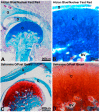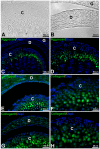Temporomandibular Joint Regenerative Medicine
- PMID: 29393880
- PMCID: PMC5855668
- DOI: 10.3390/ijms19020446
Temporomandibular Joint Regenerative Medicine
Abstract
The temporomandibular joint (TMJ) is an articulation formed between the temporal bone and the mandibular condyle which is commonly affected. These affections are often so painful during fundamental oral activities that patients have lower quality of life. Limitations of therapeutics for severe TMJ diseases have led to increased interest in regenerative strategies combining stem cells, implantable scaffolds and well-targeting bioactive molecules. To succeed in functional and structural regeneration of TMJ is very challenging. Innovative strategies and biomaterials are absolutely crucial because TMJ can be considered as one of the most difficult tissues to regenerate due to its limited healing capacity, its unique histological and structural properties and the necessity for long-term prevention of its ossified or fibrous adhesions. The ideal approach for TMJ regeneration is a unique scaffold functionalized with an osteochondral molecular gradient containing a single stem cell population able to undergo osteogenic and chondrogenic differentiation such as BMSCs, ADSCs or DPSCs. The key for this complex regeneration is the functionalization with active molecules such as IGF-1, TGF-β1 or bFGF. This regeneration can be optimized by nano/micro-assisted functionalization and by spatiotemporal drug delivery systems orchestrating the 3D formation of TMJ tissues.
Keywords: drug delivery systems; functionalization; growth factors; nanotechnology; osteochondral regeneration; regenerative medicine; scaffolds; stem cells; temporomandibular joint.
Conflict of interest statement
The authors declare no conflict of interest.
Figures





References
-
- Gopal S.K., Shankar R., Vardhan B.H. Prevalence of temporo-mandibular disorders in symptomatic and asymptomatic patients: A cross-sectional study. Int. J. Adv. Health Sci. 2014;1:14–20.
-
- Zarb G.A., Carlsson G.E. Temporomandibular disorders: Osteoarthritis. J. Orofac. Pain. 1999;13:295–306. - PubMed
Publication types
MeSH terms
Substances
LinkOut - more resources
Full Text Sources
Other Literature Sources
Medical
Miscellaneous

